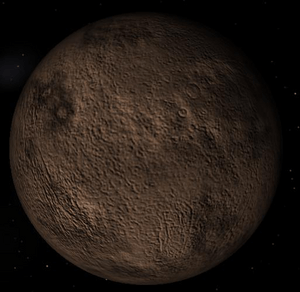38628 Huya facts for kids

Artist's impression of Huya
|
|
| Discovery | |
|---|---|
| Discovered by | Ignacio Ferrin |
| Discovery date | March 10, 2000 |
| Designations | |
| MPC designation | 38628 Huya |
| 2000 EB173 | |
| TNO Plutino |
|
| Orbital characteristics | |
| Epoch December 31, 2006 (JD 2454100.5) | |
| Aphelion | 7627.387 Gm (50.986 AU) |
| Perihelion | 4269.292 Gm (28.538 AU) |
| 5948.340 Gm (39.762 AU) | |
| Eccentricity | 0.282 |
| 91580.694 d (250.73 a) | |
|
Average orbital speed
|
4.63 km/s |
| 348.506° | |
| Inclination | 15.463° |
| 169.296° | |
| 67.637° | |
| Physical characteristics | |
| Dimensions | 480±50 km 532±25 km |
| Mass | 6.5×1019–1.8×1020 kg |
|
Mean density
|
2.0? g/cm³ |
| 0.12–0.15? m/s² | |
| 0.23–0.28? km/s | |
|
Sidereal rotation period
|
? d |
| Albedo | 0.11±0.02 |
| Temperature | ~44 K |
|
Spectral type
|
(moderately red) B-V=1.00; V-R=0.65 |
| 19.3 (opposition) | |
| 4.7 | |
| 0.024" (max) | |
38628 Huya is a small, icy world far beyond Neptune. Scientists call objects like this "Trans-Neptunian Objects" (TNOs). It was first spotted in March 2000 by a scientist named Ignacio Ferrin.
When it was first found, it had a temporary name: 2000 EB173. In August 2003, the International Astronomical Union gave it the official name "Huya." This name comes from Juyá, who is the rain god of the Wayuu people.
Contents
How Big is Huya?
When Huya was first discovered, it was one of the largest and brightest TNOs ever found. Scientists used information from the CIDA Observatory in Venezuela to study it.
Huya's Size and Shape
Astronomers believe Huya is about 530 kilometers (330 miles) wide. This is roughly the distance from London to Paris. It is not perfectly round like a planet.
What is Huya's Surface Like?
The surface of Huya looks reddish when scientists study its light. This red color might mean that its surface has special materials called tholins. These are organic materials, similar to what you might find on other icy bodies in the outer Solar System.
Huya's Journey Around the Sun
Huya takes a very long time to travel around the Sun. It completes one full orbit in about 250 Earth years.
Huya's Orbit
Because of its long orbit, Huya appears in a special position called "opposition" in early May each year. This is when Huya, Earth, and the Sun are almost in a straight line, making Huya appear brightest from Earth. Even then, it is very faint, needing powerful telescopes to see it.
| The Solar System | |||||||
|---|---|---|---|---|---|---|---|
|
|
|||||||
| Sun • Heliosphere |
Planets ☾ = moon(s) ∅ = rings |
Mercury | Venus | Earth ☾ | Mars ☾ | ||
| Jupiter ☾ ∅ | Saturn ☾ ∅ | Uranus ☾ ∅ | Neptune ☾ ∅ | ||||
| Dwarf planets | Ceres | Pluto ☾ | Haumea ☾ | Makemake | |||
| Eris ☾ | |||||||
| Small Solar System bodies |
Asteroids (minor planets) |
Groups and families: Vulcanoids · Near-Earth asteroids · Asteroid belt Jupiter Trojans · Centaurs · Neptune Trojans · Asteroid moons · Meteoroids · Pallas · Juno · Vesta · Hygiea · Interamnia · Europa |
|||||
| See also the list of asteroids. | |||||||
| Trans- Neptunians |
Kuiper belt – Plutinos: Orcus · Ixion – Cubewanos: Varuna · Quaoar · Huya |
||||||
| Scattered disc: Sedna | |||||||
| Comets | Periodic comets and non-periodic comets Damocloids · Oort cloud |
||||||
| See also the list of solar system objects | |||||||
Images for kids
-
This image shows Huya's path around the Sun. You can see how it compares to the orbits of the outer planets.
See also




